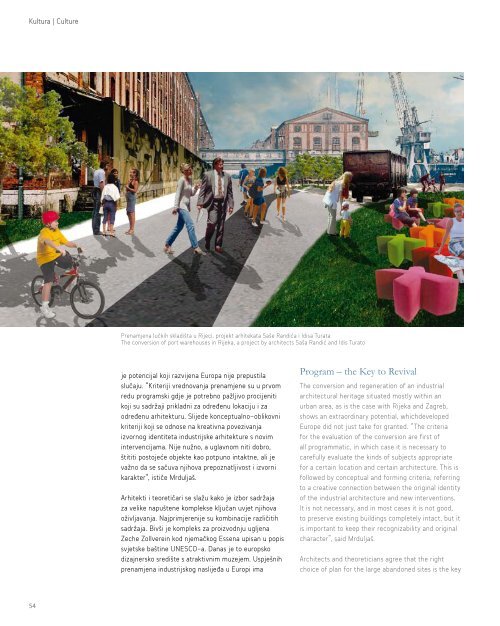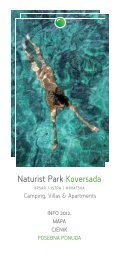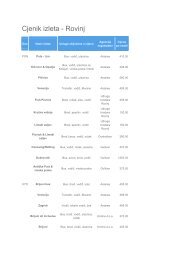Create successful ePaper yourself
Turn your PDF publications into a flip-book with our unique Google optimized e-Paper software.
Kultura | Culture<br />
Novi život svjedoka prošlosti | A New Life Is a Witness of the Past<br />
U postindustrijsko doba prerađuje<br />
se voda, energija, papir ili plastika.<br />
Prerađuju se i zgrade. U Hrvatskoj<br />
je prenamjena baštine industrijske<br />
arhitekture tek na početku.<br />
In the post-industrial era, water,<br />
energy, paper and plastics are being<br />
recycled. So are buildings. In Croatia<br />
the conversion of our industrial<br />
architectural heritage is just starting.<br />
condition for their revival. Combinations of<br />
various programs are most appropriate. The<br />
former Zeche Zollverein coal production<br />
complex at Essen was listed as a world<br />
heritage site by UNESCO. Today it is the<br />
European designer center and houses<br />
an attractive museum. There are many<br />
successful conversions of the industrial<br />
heritage in Europe, but few in Croatia.<br />
The positive side, however, is that public<br />
awareness of the necessity for its protection<br />
as belonging to a joint European cultural<br />
identity has been raised, at least when it<br />
comes to the young.<br />
Prenamjena lučkih skladišta u Rijeci, projekt arhitekata Saše Randića i Idisa Turata<br />
The conversion of port warehouses in Rijeka, a project by architects Saša Randić and Idis Turato<br />
je potencijal koji razvijena Europa nije prepustila<br />
slučaju. “Kriteriji vrednovanja prenamjene su u prvom<br />
redu programski gdje je potrebno pažljivo procijeniti<br />
koji su sadržaji prikladni za određenu lokaciju i za<br />
određenu arhitekturu. Slijede konceptualno-oblikovni<br />
kriteriji koji se odnose na kreativna povezivanja<br />
izvornog identiteta industrijske arhitekture s novim<br />
intervencijama. Nije nužno, a uglavnom niti dobro,<br />
štititi postojeće objekte kao potpuno intaktne, ali je<br />
važno da se sačuva njihova prepoznatljivost i izvorni<br />
karakter“, ističe Mrduljaš.<br />
Arhitekti i teoretičari se slažu kako je izbor sadržaja<br />
za velike napuštene komplekse ključan uvjet njihova<br />
oživljavanja. Najprimjerenije su kombinacije različitih<br />
sadržaja. Bivši je kompleks za proizvodnju ugljena<br />
Zeche Zollverein kod njemačkog Essena upisan u popis<br />
svjetske baštine UNESCO-a. Danas je to europsko<br />
dizajnersko središte s atraktivnim muzejem. Uspješnih<br />
prenamjena industrijskog naslijeđa u Europi ima<br />
Program – the Key to Revival<br />
The conversion and regeneration of an industrial<br />
architectural heritage situated mostly within an<br />
urban area, as is the case with Rijeka and Zagreb,<br />
shows an extraordinary potential, whichdeveloped<br />
Europe did not just take for granted. “The criteria<br />
for the evaluation of the conversion are first of<br />
all programmatic, in which case it is necessary to<br />
carefully evaluate the kinds of subjects appropriate<br />
for a certain location and certain architecture. This is<br />
followed by conceptual and forming criteria, referring<br />
to a creative connection between the original identity<br />
of the industrial architecture and new interventions.<br />
It is not necessary, and in most cases it is not good,<br />
to preserve existing buildings completely intact, but it<br />
is important to keep their recognizability and original<br />
character”, said Mrduljaš.<br />
Architects and theoreticians agree that the right<br />
choice of plan for the large abandoned sites is the key<br />
mnogo, u Hrvatskoj malo. Pozitivna je ipak<br />
činjenica da je svijest javnosti o nužnosti<br />
njezine zaštite kao dijela zajedničkoga<br />
europskoga kulturnog identiteta probuđena,<br />
barem kad su mladi u pitanju.<br />
U Zagrebu vrlo uspješno djeluje<br />
manifestacija “Operacija: grad” u sklopu koje<br />
se teoretski raspravlja, ali i praktično djeluje<br />
i osvaja napuštene industrijske komplekse,<br />
poput bivše tvornice Badel ili klaonice<br />
Zagrepčanka te ih se pretvara u nove javne<br />
prostore. U Rijeci najjače djeluje udruga<br />
“Klub ljubitelja buke” koja se uspješno bori<br />
za transformaciju propale tvornice Hartera<br />
u novi gradski kvart. Rezultat su glazbeni<br />
festival “Hartera“, prijedlog arhitektonskog<br />
projekta budućeg “Kulturnog centra Hartera”<br />
i više nego uspješna prezentacija Hrvatske<br />
na Bijenalu arhitekture u Veneciji.<br />
Sve vrijedno treba opstati<br />
„Danas se u teoriji ističe načelo da ni jedno<br />
razdoblje nema pravo poništavati kreativna<br />
dostignuća prošlog razdoblja, a pogotovo<br />
ne s pozicije ocjenjivanja jesu li estetski<br />
stavovi tog ostvarenja jednaki aktualnim<br />
shvaćanjima. Jednostavno rečeno, svako<br />
umjetničko djelo, kao svjedok svog vremena,<br />
ima pravo na opstanak“, riječi su ravnateljice<br />
Hrvatskog muzeja arhitekture, arhitektice<br />
Dubravke Kisić, koje možda najbolje ističu<br />
važnost očuvanja arhitektonskih ostvarenja iz<br />
nekih prošlih vremena.<br />
In Zagreb a very successful form of activism<br />
is happening: “Operation: City”, within<br />
which there are theoretical debates but also<br />
practical actions, including the re-conquest<br />
of abandoned industrial sites, like the ex-<br />
Badel factory or the Zagrepčanka meatpackaging<br />
plant, which are turned into new<br />
objects. The association “Klub ljubitelja buke”<br />
(“Noise Fan Club”) is the most effective<br />
in Rijeka, and has been successful in the<br />
fight for the transformation of the ruined<br />
Hartera factory into a new city area. The<br />
results are the “Hartera” music festival, the<br />
proposed architectural project for the future<br />
“Hartera Cultural Center”, and the more than<br />
successful representation of Croatia at the<br />
Architectural Biennale in Venice.<br />
All Things of Value Should<br />
Survive<br />
“Today the theory emphasizes the<br />
principle that no era has the right to annul<br />
the creative achievements of a former<br />
era, especially not from the position of<br />
evaluating whether the esthetic views of<br />
this achievement are equal to current ones.<br />
To put it simply, every work of art as a<br />
witness of its time has the right to survival”,<br />
these are the words of the principal of<br />
the Croatian Museum of Architecture, the<br />
architect Dubravka Kisić, which pin-point<br />
the importance of preserving architectural<br />
achievements from past eras.<br />
Bivši kompleks za proizvodnju ugljena kraj Essena danas je<br />
europsko dizajnersko središte s atraktivnim muzejem<br />
The former coal production complex at Essen, today is the<br />
European designer center with an attractive museum<br />
54 55

















